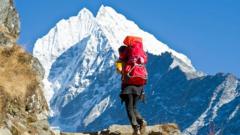Nepal has announced an initiative to waive the climbing fees for 97 of its Himalayan peaks over the next two years, in an effort to increase tourism in the country's more remote areas. This comes at a time when the fees for permits to summit Mount Everest, the highest peak in the world, will rise to $15,000 (£11,170) starting in September—the first increase in nearly ten years.
According to officials from Nepal's tourism department, the initiative is designed to promote the country's "unexplored tourism products and destinations." Mountaineering is a vital source of income for Nepal, which is home to eight of the world's ten tallest mountains. Climbing fees generated approximately $5.9 million last year, with Everest accounting for over 75% of this revenue.
The 97 peaks that will be free to climb are located in the Karnali and Sudurpaschim provinces, which range in elevation between 5,970m (19,590 ft) and 7,132m. These regions are among the poorest and least developed in Nepal, with local tourism and climbing activity remaining low due to difficult access. Himal Gautam, director of Nepal's Tourism Department, expressed hopes that the waiving of fees will boost jobs and strengthen the local economy.
However, it remains uncertain whether the government has plans to enhance infrastructure and connectivity in these remote locales, or how communities would manage a potential influx of climbers. In the past two years, only a modest 68 climbers have visited these 97 remote peaks compared to the 421 permits issued for Everest in 2024 alone. Everest has faced its own set of challenges, including overcrowding, environmental concerns, and fatal accidents among climbers.
In April 2024, Nepal's Supreme Court mandated limitations on the number of mountaineering permits for Everest and other peaks, emphasizing adherence to the mountains' capacity. Earlier this year, a 36% increase in Everest permit fees was announced for climbs outside of the peak April to May season, with costs now set at $7,500 from September to November, and $3,750 from December to February.
Additionally, Nepal's parliament is considering new regulations requiring climbers to have previously summited a mountain over 7,000m within the country, making the peaks in Karnali and Sudurpaschim suitable as training grounds for aspiring Everest climbers.
According to officials from Nepal's tourism department, the initiative is designed to promote the country's "unexplored tourism products and destinations." Mountaineering is a vital source of income for Nepal, which is home to eight of the world's ten tallest mountains. Climbing fees generated approximately $5.9 million last year, with Everest accounting for over 75% of this revenue.
The 97 peaks that will be free to climb are located in the Karnali and Sudurpaschim provinces, which range in elevation between 5,970m (19,590 ft) and 7,132m. These regions are among the poorest and least developed in Nepal, with local tourism and climbing activity remaining low due to difficult access. Himal Gautam, director of Nepal's Tourism Department, expressed hopes that the waiving of fees will boost jobs and strengthen the local economy.
However, it remains uncertain whether the government has plans to enhance infrastructure and connectivity in these remote locales, or how communities would manage a potential influx of climbers. In the past two years, only a modest 68 climbers have visited these 97 remote peaks compared to the 421 permits issued for Everest in 2024 alone. Everest has faced its own set of challenges, including overcrowding, environmental concerns, and fatal accidents among climbers.
In April 2024, Nepal's Supreme Court mandated limitations on the number of mountaineering permits for Everest and other peaks, emphasizing adherence to the mountains' capacity. Earlier this year, a 36% increase in Everest permit fees was announced for climbs outside of the peak April to May season, with costs now set at $7,500 from September to November, and $3,750 from December to February.
Additionally, Nepal's parliament is considering new regulations requiring climbers to have previously summited a mountain over 7,000m within the country, making the peaks in Karnali and Sudurpaschim suitable as training grounds for aspiring Everest climbers.



















